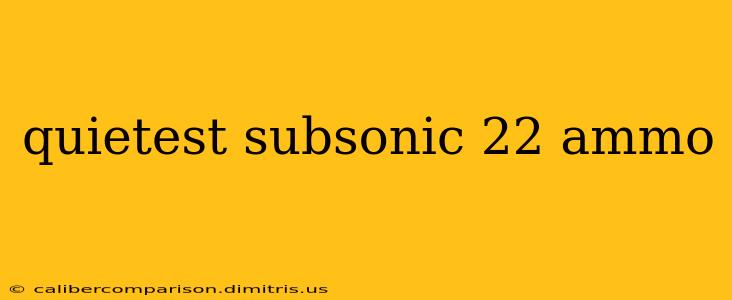Finding the quietest subsonic .22 ammo is a pursuit shared by many—from plinking enthusiasts seeking a peaceful backyard range experience to hunters prioritizing stealth. This guide dives deep into the factors affecting subsonic .22LR quietness, helping you make an informed choice. We'll explore bullet design, powder characteristics, and practical considerations to guide you towards the perfect ammunition for your needs.
Understanding Subsonic Ammunition
Subsonic ammunition is designed to travel slower than the speed of sound (approximately 1125 feet per second or 343 meters per second). This slower velocity significantly reduces the characteristic crack of a supersonic bullet breaking the sound barrier, resulting in a quieter shot. However, "quiet" is relative. Even subsonic rounds produce a distinct report, primarily from the expanding gases escaping the barrel.
Key Factors Affecting Quietness
Several factors contribute to the overall quietness of subsonic .22 LR ammo:
1. Bullet Design:
- Weight: Heavier bullets generally produce less noise due to their lower velocity, even with the same powder charge. Look for subsonic rounds with bullet weights exceeding 40 grains.
- Shape: Bullet shape influences its aerodynamic performance and thus its velocity and overall noise. Some manufacturers utilize specific designs intended to minimize noise.
- Material: While most subsonic .22 LR ammo uses lead, some manufacturers offer copper-plated or other material bullets which can influence quietness and the overall performance.
2. Powder Type and Charge:
The type and amount of powder significantly influence the bullet's velocity. Lower powder charges directly translate to slower velocities and quieter operation. Manufacturers carefully calibrate powder charges to achieve subsonic velocities without compromising reliability.
3. Suppressor Use:
Using a suppressor (or silencer) is crucial for maximizing quietness with subsonic .22 LR. A suppressor further reduces the noise generated by expanding gases leaving the barrel, significantly diminishing the overall sound signature. It's important to note that even with a suppressor, some sound will remain.
4. Rifle Characteristics:
The rifle's barrel length and design affect the pressure and velocity of the projectile as it leaves the barrel. A longer barrel can potentially slightly increase velocity, negating some quietness benefits, though the impact is typically minor with subsonic ammunition.
Top Contenders for Quietness (without specific brand endorsements):
While specific product endorsements are beyond the scope of this article, consider these characteristics when researching subsonic .22 LR ammo:
- Heavier grain bullets: Look for options exceeding 40 grains.
- Low-velocity specifications: Pay attention to the stated muzzle velocity—aim for something consistently below the speed of sound.
- Reviews and testing: Search online forums and review sites for user experiences and independent testing data focusing on sound reduction.
Beyond Ammunition: Additional Noise Reduction Tips
Even with the quietest subsonic ammunition, other factors influence overall noise levels:
- Proper shooting techniques: A consistent and firm grip minimizes extra noise from the rifle.
- Environmental factors: Shooting outdoors can lead to additional ambient noise, reducing the perceived effectiveness of quiet ammunition.
Conclusion: The Pursuit of Silent Shots
Choosing the quietest subsonic .22 ammo is a balance of bullet design, powder characteristics, and suppressor usage. Prioritize heavier-grain bullets, lower velocities, and thorough research based on independent testing and user reviews. Remember that even the quietest option will generate some sound, so managing expectations and employing proper techniques are key to maximizing your quiet shooting experience.

